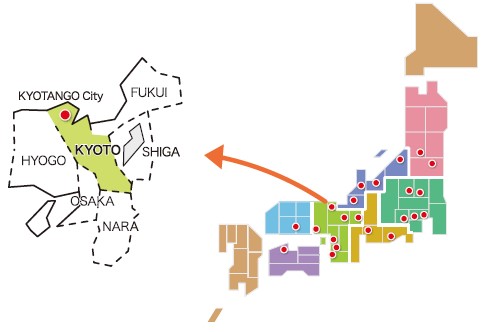Tango Region

The largest silk fabric producer
The Tango textile region, located in northern Kyoto Prefecture, is Japan’s largest producer of silk fabrics. It served as a meeting place for Izumo and Yamato cultures (corresponding to the present-day provinces of Shimane and Nara respectively) and even traded with China. Its long history of silk fabric trading dates all the way back to the Nara Period (710-784). In the Edo era (1603-1868), ‘Tango Chirimen’ (Tango crepe) was produced based on a technique of twisting yarns, which was brought in from Nishijin by silk merchants including Kinuya Saheiji. Despite the harshest of winters and the cold wind and snow of the Tango region, its high-quality water and moderate humidity were considered ideal for producing Chirimen (crepe) fabrics.
Presently, the region supplies approximately 70% of the plain white kimono cloths produced domestically as well as being a production hub for Nishijin in Kyoto. Clothing needs met in the latter role include weaving fabrics for wide-ranging products, yarn-dyed items like obi (sash belts) and ties, single-width fabrics for shawls and scarves to bring out the best of the Chirimen (crepe) technique, plus double-width textiles like silk and polyester for clothing. The region aims to be an integrated producing area for top-class woven and dyed fabrics by proposing finishing techniques: stress-resistance and yellowing prevention to offset the natural weakness of silk.
